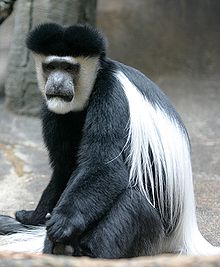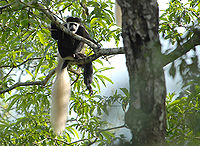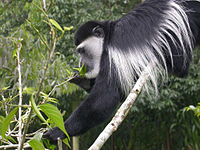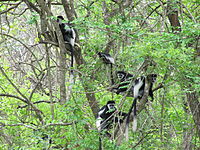- Mantled guereza
-
Mantled guereza[1] 
Mantled Guereza at the Henry Doorly Zoo Conservation status Scientific classification 
Kingdom: Animalia Phylum: Chordata Class: Mammalia Order: Primates Family: Cercopithecidae Genus: Colobus Species: C. guereza Binomial name Colobus guereza
Rüppell, 1835
Mantled Guereza range The mantled guereza (Colobus guereza), also known simply as the guereza, the eastern black-and-white colobus,[2] or the Abyssinian black-and-white colobus,[3] is a black and white colobus monkey, a kind of Old World monkey. It is native to much of west central and east Africa, including Cameroon, Equatorial Guinea, Nigeria, Ethiopia, Kenya, Tanzania, Uganda and Chad.
Contents
Classification
There are several distinct subspecies of this colobus:[1]
- Colobus guereza guereza
- Colobus guereza occidentalis
- Colobus guereza dodingae
- Mt. Uarges Guereza or Percival's black-and-white colobus, Colobus guereza percivali
- Colobus guereza matschiei
- Colobus guereza kikuyuensis
- Colobus guereza caudatus or Kilimanjaro guereza
Description
The mantled guereza has a distinctive pelage, being mostly black with a white mantle, also known as an ornamentation, and tail tuft. The bands that make up the mantle extend from the shoulders to the hips and connect around the lower torso. The tail tuft varies in how much it takes up along the tail. Subspecies vary in color variations of these features.[4] There is also white hair surrounding the face with the hair between the cheeks being bushy. The thigh has a white stripe.[4] The guereza typically weighs 9.3-13.5 kg (20.5-29.8 lbs) and 7.8-9.2 kg (17.2-20.3 lbs) for males and females respectively.[5] The head and body length averages 61.5 cm (24.2 in) for males and 57.6 cm (22.7 in) for females.[5] Like most colobi, the guereza has a reduced thumb that is rudimentary.[5] There is variation among the subspecies in dental sexual dimorphism. In some, there is lesser difference between those of the males and females, in others, males have larger teeth than females and in others the reverse is true.[6]
Ecology
Range and habitat
The guereza is distributed throughout Equatorial Africa. It ranges from Nigeria and Cameroon in the west though the northern Democratic Republic of the Congo and southern Sudan and into Ethiopia, Kenya, Uganda and northern Tanzania in the east.[5][4] Guerezas live in both deciduous and evergreen forests. They mainly inhabit forest and savanna woodlands and often extend into highland and montane forests.[7] They can be found in other forest habitats, both primary and secondary, such as riparian, gallery and upland forests. They are particularly common in forests near river and at high elevations.[8] They can be found in elevations as high as 3300 m (10,826.8 ft). [9] This species prefers forests of secondary growth and chooses them over old growth forests when both are available.[10] It is likely at the guerezas prefer second growth forests due to the greater plant species diversity in some of them and weaker chemical defensive from the plants.[10] Guerezas sometimes visit swamps[11] as well as human altered habitats such as eucalyptus plantations, which may be visited when the monkeys need to make up for nutritional deficiencies.[9]
Diet and predation
Despite its reputation as a leaf-eater, the guereza is not an obligate folivore.[7] While it mainly eats leaves and fruit, its diet is quite variable. It may consume bark, wood, seeds, flowers, petioles, lianas, aquatic-plants, arthropods, soil and even concrete from buildings The amount of each food item in their diet varies by area and time of year. Leaves usually make up over half of their diet but fruits occasionally predominate.[7][9] When foraging for leaves, guerezas prefer young ones over old. With fleshy fruits, guerezas prefer to eat them unripe, which may serve to reduce competition with primates that eat ripe fruits.[12] The guereza consumes a number of species but only several make up most of its diet at a specific site.[12][11] Like all colobi, guerezas are able to digest leaves and other plant fibers with a large, multi-chambered stomach that contains bacteria in certain areas.[13] The main predator of the guereza is the crowned hawk-eagle.[14] Other birds of prey that prey on it include the Verreaux's eagle.[9] The common chimpanzee is known to hunt the guereza.[15] The leopard is a another potential predator.
Activities
This species is primarily arboreal, but does sometimes descend to and travel on the ground, perhaps moreso than most other colobines. The guereza is diurnal, being active during the daytime. It spends most of the day resting.[16] The second most common activity is usually feeding, although traveling is sometimes the second most common.[16] During the day, guerezas have long rest periods in between periods of moving and feeding. Sometime after dawn, guerezas leave their sleeping trees and later return to them at dusk.[16] To a lesser extent, other activities are preformed, including grooming, greeting, playing and being vigilant.
Life history
Social structure
Guerezas live in cohesive social groups usually containing of 3-15 memebers.[17] The groups usually contain one male, several females and juveniles. In some populations, groups containing several males are common. In multi-male groups, interactions between males tend to be aggressive with one being dominant. Some males may be forced out of the group.[16] Multi-male groups may contain father-son pairs or unrelated males.[18] Males that are not part of groups either live solitarily or with other 0utside males in bachelor groups. The females and juveniles form the core of the social groups and they are matrilineally related.[16] Females rarely disperse from their natal groups, expect possibly when they dissolve.[16] Males on the other hand, usually leave as subadults or adults. They may start out being solitary and or in bachelor groups. They gain entry into a social group either by being on the periphery or staging a takeover.[9] Within the main social groups, most interactions tend to be friendly. Allogrooming is an important part of guereza interactions and mostly occurs between females.[16] The adult males rarely groom in the groups. While not strictly territorial, guereza groups can be aggressive towards each other.[17] In some populations, groups may defend core areas, resources and mates. It is the males that participate in agonistic inter-group encounters but female may do so as well.[17] Aggressive encounters between groups usually involve chases, displays and vocalizations rather than physical contact.[17]
Reproduction and parenting
The guereza has a polygynous harem-based mating system.[16] Mating solicitations are done both by males and females, half of the time for each.[19] To solicit mating, a guereza will approach its partner and make low-intensity mouth clicks or tough-smacks.[20] During copulation, the males grasps the female’s ankles and trunk from behind.[21] Most copulations take place in the groups but extra-group copulations have been recorded.[21] In multi-male groups, sometimes more than one male can mate with the females.[17] The gestation period lasts 158 days with a 16-22 month interbirth interval.[9] Infants are born with pink skin and white hair. The hair darkens as they age and by 3-4 months they attain adult coloration. Male usually gain their coloration before females.[22] The newborn guereza is dependent on its mother and must cling to her. As they grow older, infants can move on their own and will actively return to their mothers.[23] The infants take up most of the attention in the groups, especially by the females. Multiple females may handle an infant although infants are uncomfortable with females that are not their mothers.[24] The males are mostly uninterested in the infants early on but their interest increases when they are 4-5 weeks.[23] Infants can eat vegetation at about 8-9 weeks and by 50 weeks they are fully weaned and no longer cling to their mothers.
Communication
The most notable vocalization of the guereza is the "roar", which is made mainly at night or dawn by males. The sound of a roar can be carried for up to a mile. Only one male in a group will roar, even in multi-male groups. Roars are used for long distance communication. When one male starts roaring, neighboring males will start to roar as well.[21] There is variation is the roars of males which could signal the status of their group and fighting ability.[21] With a roar, a male can advertise his body size; both actual and exaggerated.[25] Other vocalizations are made as well. Males may snort, possibly as an alarm call.[26] "Purrs" are made before group movements. Female and infant may "caw" when under light stress. When in strong stress, females and sub-adults will squeak or scream, particularly when infants are threatened.[26] "Tongue-clicking" is made during mild aggression.[26] In addition to vocalizations, guerezas make several different body postures and movement as well as tactile communications.
Conservation status
Because it can use dry and gallery forests and will travel on the ground, the guereza is among the least threatened colobine species.[7] The IUCN lists it as Least Concern because "although locally threatened in parts of its range, this widespread species is not thought to be declining fast enough to place it in a higher category of threat."[2] Unlike most other primate species, the guereza cope with habitat degradation and can thrive in degraded forests.[27] Sometimes, logging may increase the number of preferred food trees for guerezas and the monkeys are more abundant in logged areas than unlogged ones.[7] Nevertheless, complete forest clearings cause their numbers to decline as was the cause in Uganda.[28] Guerezas are also threatened by hunting/harvesting for their meat and skins. Guereza meat has been sold on the bushmeat trade for $4-9 US.[29] The guereza skins have been sold for fashion or the tourist trade.[30]
References
- ^ a b Groves, C. (2005). Wilson, D. E., & Reeder, D. M, eds. ed. Mammal Species of the World (3rd ed.). Baltimore: Johns Hopkins University Press. pp. 168. OCLC 62265494. ISBN 0-801-88221-4. http://www.bucknell.edu/msw3/browse.asp?id=12100605.
- ^ a b c Kingdon, J., Struhsaker, T., Oates, J. F., Hart, J. & Groves, C. P. (2008). Colobus guereza. In: IUCN 2008. IUCN Red List of Threatened Species. Downloaded on 4 January 2009.
- ^ Wolfheim, J.H. (1983) Primates Of The World: Distribution, Abundance And Conservation Routledge ISBN 3718601907
- ^ a b c Groves C. 2001. Primate taxonomy. Washington DC: Smithsonian Inst Pr.
- ^ a b c d Napier PH. 1985. Catalogue of primates in the British museum (natural history) and elsewhere in the British Isles, part III: family Cercopithecidae, subfamily Colobinae. London: British Museum (Natural History).
- ^ Hayes VJ, Freedman L, Oxnard CE. 1995. "The differential expression of dental sexual dimorphism in subspecies of Colobus guereza". Intl J Primatol 16(6):971-96.
- ^ a b c d e Oates JF. 1994. "The natural history of African colobines". In: Davies AG, Oates JF, (editors). Colobine monkeys: their ecology, behaviour and evolution. Cambridge (UK): Cambridge U Pr. p 75-128.
- ^ Dunbar RIM. 1987. "Habitat quality, population dynamics, and group composition in colobus monkeys (Colobus guereza)". Intl J Primatol 8(4):299-329.
- ^ a b c d e f Dunbar RIM, Dunbar EP. 1974. "Ecology and population dynamics of Colobus guereza in Ethiopia". Folia Primatol 21:188-208.
- ^ a b Lwanga JS. 2006. "Spatial distribution of primates in a mosaic of colonizing and old growth forest at Ngogo, Kibale National Park, Uganda". Primates 47(3):230-8.
- ^ a b Oates JF. 1978. "Water-plant and soil consumption by guereza monkeys (Colobus guereza): a relationship with minerals and toxins in the diet?" Biotropica 10(4):241-53.
- ^ a b Harris TR, Chapman CA. 2007. "Variation in diet and ranging of black and white colobus monkeys in Kibale National Park, Uganda". Primates 48(3):208-21.
- ^ Oates JF, Davies AG, Delson E. 1994. "The diversity of living colobines". In: Davies AG, Oates JF, (editors). Colobine monkeys: their ecology, behaviour and evolution. Cambridge (UK): Cambridge U Pr. p 45-73.
- ^ Struhsaker TT, Leakey M. 1990. "Prey selectivity by crowned hawk-eagles on monkeys in the Kibale Forest, Uganda". Behav Ecol Sociobiol 26(6):435-43.
- ^ Ihobe H. 2001. "Hunting attempt by chimpanzees on Abyssinian colobus at the Kalinzu Forest, Uganda". Pan Afr News 8(2):31-2.
- ^ a b c d e f g h Bocian CM. 1997. "Niche separation of black-and-white colobus monkeys (Colobus angolensis and C. guereza) in the Ituri Forest". PhD dissertation, City University of New York.
- ^ a b c d e von Hippel FA. 1996. "Interactions between overlapping multimale groups of black and white colobus monkeys (Colobus guereza) in the Kakamega Forest, Kenya". Am J Primatol 38(3):193-209.
- ^ Harris TR, Caillaud D, Chapman CA, Vigilant L. 2009. "Neither genetic nor observational data alone are sufficient for understanding sex-biased dispersal in a social-group-living species". Mol Ecol 18:1777-90.
- ^ Harris TR, Monfort SL. 2006. "Mating behavior and endocrine profiles of wild black and white colobus monkeys (Colobus guereza): toward an understanding of their life history and mating system". Am J Primatol 68(4):383-96.
- ^ Grimes KH. 2000. "Guereza dietary and behavioural patterns at the Entebbe Botanical Gardens". MA thesis, University of Calgary. 146 p.
- ^ a b c d Harris TR. 2005. "Roaring, intergroup aggression, and feeding competition in black and white colobus monkeys (Colobus guereza) at Kanyawara, Kibale National Park, Uganda". PhD dissertation, Yale University. 253 p.
- ^ Ackerman DE. 1991. "A study of the colobus monkey (Colobus guereza kikuyuensis)". Anim Keep For 18(4):164-71.
- ^ a b Horwich RH, Manski D. 1975. "Maternal care and infant transfer in two species of Colobus monkeys". Primates 16(1):49-73.
- ^ Oates JF. 1977. "The social life of a black-and-white colobus monkey, Colobus guereza". Z Tierpsychol 45:1-60.
- ^ Harris TR, Fitch WT, Goldstein LM, Fashing PJ. 2006. "Black and white colobus monkey (Colobus guereza) roars as a source of both honest and exaggerated information about body mass". Ethology 112(9):911-20.
- ^ a b c Marler P. 1972. "Vocalizations of east African monkeys II: black and white colobus". Behaviour 42:175-97.
- ^ Chapman CA, Balcomb SR, Gillespie TR, Skorupa JP, Struhsaker TT. 2000. "Long-term effects of logging on African primate communities: a 28-year comparison from Kibale National Park, Uganda". Conserv Biol 14(1):207-17.
- ^ Chapman CA, Naughton-Treves L, Lawes MJ, Wasserman MD, Gillespie TR. 2007. "Population declines of colobus in western Uganda and conservation value of forest fragments". Intl J Primatol 28(3):513-28.
- ^ Eves HE, Ruggiero RG. 2000. "Socioeconomics and the sustainability of hunting in the forests of northern Congo (Brazzaville)". In: Robinson JG, Bennett EL, (editors). Hunting for sustainability in tropical forests. New York: Colombia U Pr. p 427-54.
- ^ Oates JF. 1977. "The guereza and man". In: Rainier III (Grimaldi) Prince of Monaco, Bourne GH, (editors). Primate conservation. New York: Academic Pr. p 419-67.
External links
- Primate Info Net Colobus guereza Factsheet
- ARKive - images and movies of the Eastern black-and-white colobus (Colobus guereza)
Categories:- IUCN Red List least concern species
- Colobine monkeys
- Mammals of Africa
- Mammals of Ethiopia
- Fauna of Tanzania
- Animals described in 1835
Wikimedia Foundation. 2010.









